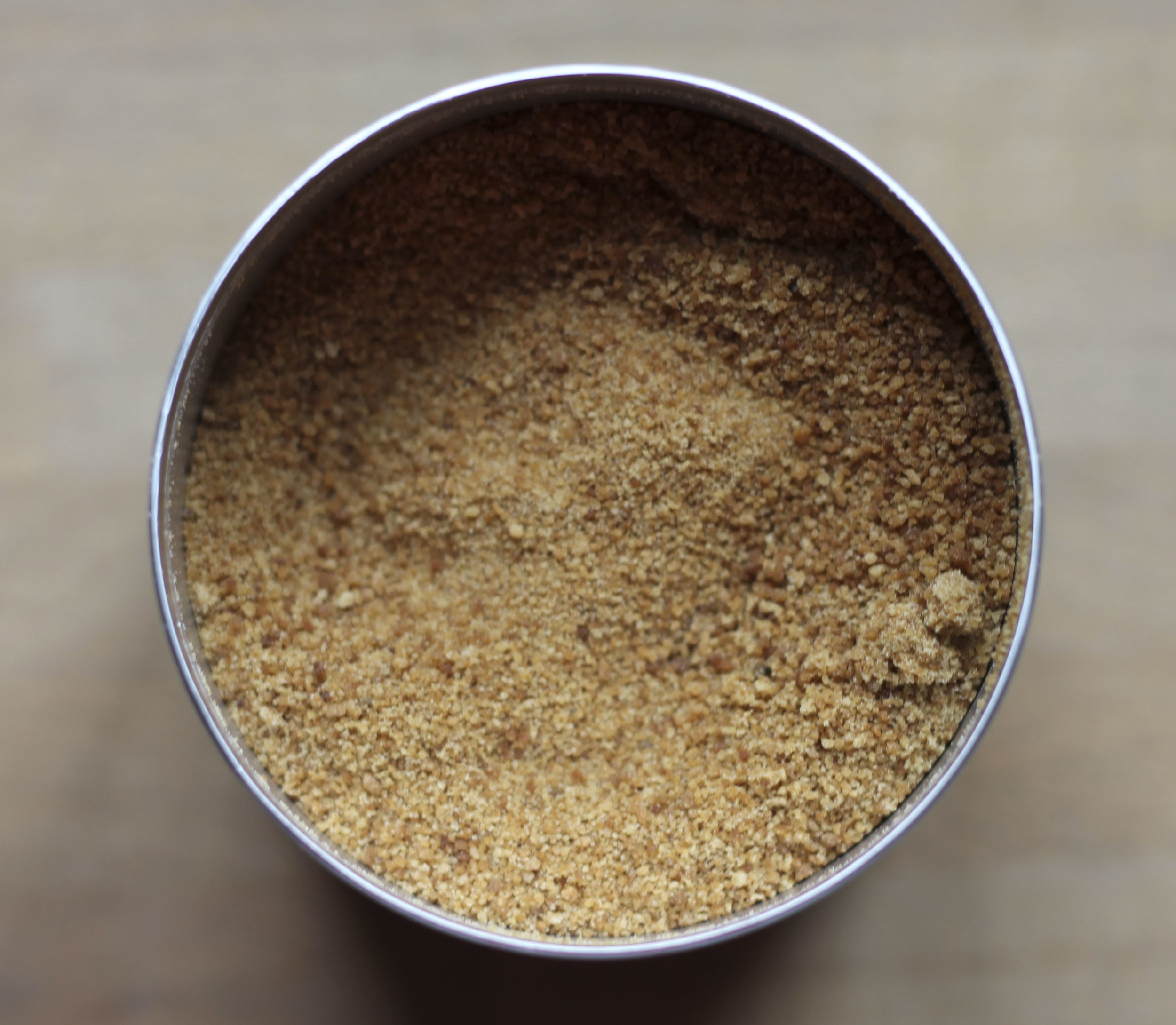Kokosblütenzucker*Coco blossom sugar*
Kokosblütenzucker ist der neue Star unter den niedrig-glykämischen Süßungsmitteln. Kokoszucker bietet eine tolle Alternative zu anderen Süßungsmitteln. Welche Vorteile hat Kokosblütenzucker? Wie wird er hergestellt? Wie schmeckt er und wie verwendet man ihn? - All das erfahren Sie hier.
Kokosblütenzucker - Süße aus der Kokosblüte
Kokosblütenzucker wird aus dem Nektar der Kokospalme hergestellt. Schneidet man die Blütenknospe der Kokospalme an, tritt dort ein Saft aus, welcher als Kokosnektar bezeichnet wird. Dieser Nektar wird in einem Behälter aufgefangen und entweder aufgekocht oder bei niedriger Temperatur mit einem so genannten Vakuum-Dampfkocher bearbeitet, um die Kokosblütenzuckerkristalle entstehen zu lassen. Eine Kokospalme kann so für über 70 Jahre Nektar hervorbringen.
Kokosblütenzucker - Nachhaltige Produktion
Gerade in Bezug auf Kokosfett oder andere Kokosprodukte entfacht sich immer wieder die Diskussion über die Nachhaltigkeit der Kokosplantagen. Es gibt nur wenige Hersteller, die Kokosprodukte wirklich nachhaltig und ökologisch produzieren. Man sollte sich daher vor dem Kauf immer bei der entsprechenden Ölmühle oder Kokosblütenzuckerproduzenten erkundigen, ob dies der Fall ist.
Nachhaltig geführte Kokosplantagen schonen den Regenwald vor der Abholzung, während nicht nachhaltige Kokosplantagen meist auf dem Boden eines ehemaligen Regenwalds angepflanzt werden.
Ein wichtiger Punkt in Bezug auf eine nachhaltige Produktion ist jedoch auch, dass für die Herstellung von Kokosblütenzucker die Kokospalme nicht gefällt werden muss. Man benötigt demnach auch weniger Fläche, als wenn man ständig neue Kokospalmen anpflanzen müsste.
Kokosblütenzucker - Niedriger glykämischer Index
Kokosblütenzucker ist vor allem wegen seinem sehr geringen glykämischen Wert bekannt geworden. Der glykämische Wert eines Lebensmittels gibt an, wie stark dieses den Blutzuckerspiegel ansteigen lässt. Niedrig-glykämische Nahrungsmittel sind für unser Wohlbefinden sehr förderlich, da sie keinen rapiden sondern einen langsamen und gleichmäßigen Anstieg des Blutzuckerspiegels hervorrufen. Hoch-glykämische Lebensmittel verursachen hingegen einen Anstieg des Blutzuckers innerhalb kürzester Zeit. Haushaltszucker und viel Lebensmittel, die isolierte Kohlenhydrate enthalten, zählen zu den hoch-glykämischen Lebensmitteln.
Das Insulin ist dazu da, um die Glucose aus dem Blut in die Zellen zu befördern (die Energie zu verteilen) und so den Blutzuckerspiegel zu senken. Wird nun nach dem Verzehr eines hoch-glykämischen Lebensmittels viel mehr Insulin ausgeschüttet, als dies nach dem Verzehr eines niedrig-glykämischen Lebensmittels der Fall ist, sinkt der Blutzuckerwert in Kürze auf ein Minimum. Dieser geringe Glucosespiegel liegt meist sogar noch unter dem Blutzuckerwert vor der Mahlzeit.
Dieser Mechanismus erklärt, weshalb der Verzehr von hoch-glykämischen Produkten zur Gewichtszunahme beiträgt – durch den geringen Blutzuckerspiegel entsteht nämlich ein neues Hungergefühl. Die Achterbahnfahrt des Blutzuckers nach dem Verzehr von hoch-glykämischen Lebensmitteln führt dazu, dass man im Laufe des Tages automatisch mehr isst.
Kokosblütenzucker fördert im Vergleich zu hoch-glykämischen Süßungsmitteln eine langsamere Energieausschüttung, die einerseits länger sättigt und andererseits keine Zuckerhochs und -tiefs verursacht. Daher ist Kokosblütenzucker auch ausgezeichnet für Diabetiker geeignet.
Kokosblütenzucker - Nährstoffreich und gesund
Kokosblütenzucker weist nicht nur einen niedrigen glykämischen Wert auf, sondern er ist ausserdem ein sehr nährstoffreiches Süßungsmittel. Er ist reich an Kalium, Magnesium, Eisen, Bor, Zink, Schwefel und Kupfer. Auch diese Minarelstoffe und Spurenelemente machen Kokosblütenzucker zu einer gesunden Alternative zu herkömmlichem Zucker.
Verwendung und Geschmack von Kokosblütenzucker
Das tolle an Kokosblütenzucker ist, dass man ihn 1:1 wie braunen Zucker verwenden kann. Kokosblütenzucker schmeckt außerdem nicht nach Kokos - wie der Name vielleicht vermuten lässt - sondern hat einen kräftigen, caramelligen Geschmack.
Achtet beim Kauf von Kokosblütenzucker vor allem auf seine Reinheit. Manche Kokosblütenzuckerprodukte werden mit anderen Zuckern gestreckt. Und wie oben bereits erwähnt, sollte man auch auf einen nachhaltigen Anbau wert legen.
DANKE an Zentrum der Gesundheit!
DANKE an Zentrum der Gesundheit!
*Coco blossom sugar is the rising star among the low glycaemic sweeteners. Coco sugar is a great alternative to other sweeteners. What kind of advantages does it offer? How is it produced? What does it taste like and how should it be used? You will learn all of that here.
Coco blossom sugar - Sweetness of the coco blossom
Coco blossom sugar is made of the nectar of the coconut palm. If you cut the blossom bud, a juice oozes out which is called coco nectar. This nectar is caught in a container and either boiled or processed in a so called vacuum steam cooker at a low temperature to create the coco sugar crystals. A coco palm used in this way can produce nectar for over 70 years.
Coco sugar - sustainable production
Especially coco fat or other coconut products again and again spark discussions about the sustainability of coconut plantations. There are only very few manufacturers who produce coconut articles which are truly sustainable and ecological. So you always should inquire at the respective oil-mills or the coco blossom producers if this is the case if you want to buy something.
Coco plantations which are run in a sustainable way save the rain forests from deforestation while non-sustainable coco plantations are usually planted on the soil of former rain forests.
An important point regarding sustainable production is also the fact that no coconut palms have to be cut down for the production of coco blossom sugar. Therefore, you also need less space than you would if you had to plant new palms constantly.
Coco blossom sugar - low glycaemic index
Coco blossom sugar has gained its renown particularly because of its especially low glycaemic value. The glycaemic value of a victual indicates how much the blood sugar level will increase through its intake. Victuals with a low glycaemic index are quite beneficial for our well-being since they will cause a slow and continuous rise of the blood sugar level instead of a rapid one. Foodstuffs with a high glycaemic value, on the other hand, cause a sudden surge of the blood sugar level in a very brief period of time. Normal sugar and many foodstuffs containing isolated carbohydrates are counted among the highly glycaemic victuals.
It's the insulin's task to transport glucose from the blood into the cells (to distribute the energy) and in this manner lower the blood sugar level. But if a lot more insulin is released due to the intake of a highly glycaemic product than it would be the case with low-glycaemic food, the blood sugar level will sink to a minimum very quickly. This low glucose-level quite often is even below the one before the meal.
This mechanism explains why the intake of highly glycaemic products contributes to weight gain - due to the low blood sugar level, the sensation of hunger will arise again quickly. The roller-coaster ride after the intake of highly glycaemic foodstuffs will automatically cause you to eat more during the day.
Compared to highly glycaemic sweeteners, coco blossom sugar contributes to a slower release of energy which on the one hand satiates you longer and on the other hand won't cause any sugar highs or lows. For this reason, coco blossom sugar is also very suitable for diabetics.
Coco blossom sugar - nutritious and healthy
Coco blossom sugar not only exhibits a low glycaemic value but is furthermore a nutritious sweetener. It's rich in potassium, magnesium, iron, boron, zinc, sulfur and copper. These mineral substances and trace elements also make coco blossom sugar a healthy alternative to conventional sugar.
Use and taste of coco blossom sugar
The great thing about coco blossom sugar is that you can use it just like brown sugar. Coco blossom sugar furthermore doesn´t taste like coconut - as you may think because of the name - but has a strong, caramel-like taste. When buying coco blossom sugar, you should pay particular attention to its purity. Some coco blossom sugar products are diluted with other sugars. And as mentioned above, you should also appreciate sustainable production.
Thanks to the Zentrum für Gesundheit!*


